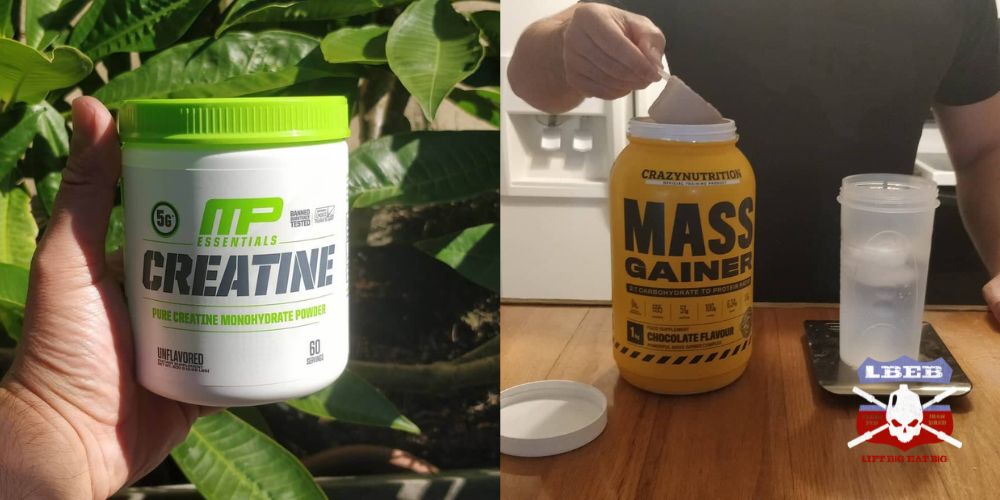The supplement world is rife with misinformation. Here are a couple of my favorites: “Mass gainer will make you fat.” “Creatine is a steroid.” The list goes on. You may have worried about some of these mythical side effects. To keep yourself safe, you’re deciding between a mass gainer and creatine. But what’s their purpose?
The main difference between mass gainers and creatine is the purpose they are taken, the mechanism they act, and the caloric value between supplements. Mass gainer helps consume more calories while creatine enhances strength and power performance.
Mass gainer and creatine do two different jobs, so how do you know which one to take?
Table of Contents
What Is Mass Gainer?
Mass gainer is a protein-formulated supplement with carbohydrates to create a caloric bomb. It’s essentially a meal replacement for gaining weight. The primary purpose of a mass gainer is to make it easier to consume excess calories by drinking them.
Stuffing your mouth with food multiple times daily becomes a chore as a skinny guy or skinny girl. Your jaw aches, and thinking of that next piece of chicken or slice of pizza makes you nauseous. But sipping on a mass gainer is much more palatable.
What Is Creatine?
Creatine is a naturally occurring amino acid, especially in seafood and red meat. This amino acid is a super-enhancer of the a-lactic energy system, improving short burst, high-intensity activities like lifting weights or sprinting.
Since it’s near impossible to get the required performance-enhancing dose of creatine through food alone, creatine is available in powder form.
Mass Gainer vs. Creatine: What’s The Difference?

There are three main differences that I believe separate mass gainer and creatine.
Purpose
This is where the main difference lies. While both supplements can help you gain weight, that is not creatine’s primary purpose. It is a positive side effect. Instead, creatine helps to increase strength, the number of reps performed at a given load, all-out maximal sprinting, and power output [1][2].
It’s a legal effective performance enhancer! Typically, if you are a creatine responder, you’ll gain, on average, 1.2% of bodyweight in water weight [3].
This is the muscle becoming saturated with creatine to regenerate energy. If you’re a creatine non-responder like me, you’ll see no change in bodyweight, but that doesn’t mean you won’t get the benefits from creatine.
On the other hand, mass gainer isn’t a performance enhancer. Instead, its purpose is to help you gain weight when you can’t get enough calories from food. Further, it makes a great meal replacement when you’re busy on the run.
Mechanism
First, let’s look at how each product helps you gain weight. Mass gainer makes it easier to consume more calories than you use daily. Your body uses these extra calories to build new tissue or is stored as body fat. Either way, you’re gaining weight.
Creatine doesn’t add new tissue directly. Instead, you retain more water within the muscles to store more phosphocreatine. What’s the purpose of this? Phosphocreatine, or PCr for short, is needed for rapid energy regeneration for muscles to contract and produce force.
To break it down simply, muscles use adenosine triphosphate (ATP) as energy to contract. As ATP is used, it loses a phosphate molecule making it adenosine diphosphate (ADP) or two phosphate molecules.
Creatine binds to phosphate to make PCr which sits within the added water in the muscle, waiting to be used.
To replenish ADP back to ATP, it needs a phosphate taken from the stored PCr. PCr is the fastest energy source to regenerate energy quickly for short-term, high-intensity activity. The anaerobic lactic and aerobic energy systems produce more ATP, but it is a slower process.
This is why you can lift more reps at a given load, are stronger, and can go harder during a maximum-effort sprint.
Caloric Value Per Serving
Since creatine isn’t designed to be a mass gainer, one serving is only 25 calories. 5 g of an amino acid since 1 g of protein equals 4 calories. Mass gainers can range anywhere between 400 to 1300 calories per serving.
Some mass gainers recommend a serving size of 2 & ½ cups of powder which is insane to me. Avoid creatine that is flavored. Adding a scoop of pure creatine powder to your protein shake or smoothie is much easier.
Can You Combine Mass Gainer & Creatine?
You can combine creatine and mass gainer with no ill effects. In fact, some mass gainers, such as my favorite Crazy Nutrition Mass Gainer, have creatine in them. If your mass gainer doesn’t have creatine, you can always scoop 5 g into your shaker, saving you from having to dry scoop creatine.
Mass Gainer vs. Creatine: Which Should You Take?
If you compete in a weight-class sport or do not want to gain weight, use creatine instead of a mass gainer. Creatine is one of the most effective sports supplements on the market. If you struggle to build muscle and gain weight, use a mass gainer and creatine.
There is no need to pick between the two when adding mass. Both serve different purposes, and taking both will only benefit you.
References
1. Rawson, E. S., & Volek, J. S. (2003). Effects of creatine supplementation and resistance training on muscle strength and weightlifting performance. The Journal of Strength & Conditioning Research, 17(4), 822-831.
2. Mielgo-Ayuso, J., Calleja-Gonzalez, J., Marqués-Jiménez, D., Caballero-García, A., Córdova, A., & Fernández-Lázaro, D. (2019). Effects of creatine supplementation on athletic performance in soccer players: a systematic review and meta-analysis. Nutrients, 11(4), 757.
3. Branch, J. D. (2003). Effect of creatine supplementation on body composition and performance: a meta-analysis. International journal of sport nutrition and exercise metabolism, 13(2), 198-226.
